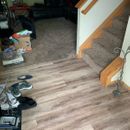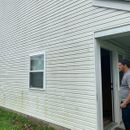Wet floor in slab-on-grade home
Hello, y’all!
I was called out to a property today at which the last 2 tenants have been able to move out early on their lease, 7 other technicians/companies have inspected and perplexed and now, a third tenant is planning to vacate unless the issue is resolved. Normally, I arrive on these sorts of jobs to find an easy explanation that’s just outside the wheelhouse of a pretty-good tech, but a tech that hasn’t quite seen enough weird problems. In this case, I’m probably that guy… So, I’m reaching out for help.
The home is slab-on-grade (technically, the slab is slightly elevated about 4″ above surrounding soil). As you walk into the home, the entire foyer is soaked underneath the LVP (luxury vinyl plank) and the saturation covers an approximate area of 60 sf. There’s no apparent source of water, but to rule out the obvious culprits – there’s a spigot near the area, on an outside wall but there’s not change on the meter after 15 minute test period. There’s two windows, but one is under a well detailed porch that gets very little rainfall and I removed a row of siding under the other to check the OSB and it’s in perfect condition with no visible signs of saturation, long term wetness or rot. All of the gutters drain correctly and away from the foundation.
I attached some pics to help illustrate the issue. Any help/advice would be very much appreciated. Thanks!
-Mat
Climate Zone 5
GBA Detail Library
A collection of one thousand construction details organized by climate and house part














Replies
I'd assume that the water is coming from the ground. The slab was likely installed without a vapor barrier, or installed with sand above the vapor barrier. That means there is moisture in direct contact with the concrete, and over time that moisture will travel through the concrete. It doesn't matter how well you direct bulk water away from the house, soil is just naturally a little damp, and a little dampness is all it takes.
The reason only the area under the vinyl flooring is affected is because the vinyl blocks vapor transmission -- the water can move evaporate through the carpet just fine, and even from beneath tiles (through the grout), but is trapped behind the vinyl. Thus the concrete stays wet. Worse still, the wet concrete is alkaline and will de-bond the flooring.
This article has some more information, and some solutions:
https://www.buildingscience.com/documents/insights/bsi-003-concrete-floor-problems
Edit: Technically, it is possible that the slab was installed with a vapor barrier beneath it, but the vapor barrier does not extend up the sides of the slab. In that case, the water would be entering the concrete from the side of the slab, and spreading inward. I don't think that changes things much, but I thought it worth mentioning. If this is the case, I would expect the flooring to be less wet further from the edge.
As an additional note, it would be a good idea to inspect underneath cabinets or any other large pieces of furniture that have the potential to block vapor transmission. While the carpet itself is fine, a large bookshelf or similar object placed on top could easily lead to moisture damage.
Aedi has given you good advice. I would only add:
If the foundation is 4" above grade (not the 8" called for in most codes), then the bottom of the slab is at grade, meaning that any time the water-table moves close to the surface it may wick moisture up into the slab.
- There is a very small chance that the moisture comes from a leak in the water supply below the slab. Checking the meter when no water is in use might be prudent.
Is there any piping in the slab? Either for radiant heat or just domestic water supply lines?
Not likely, but I have had one project where a leaking pipe in the slab was the culprit.
Peter
Peter - nope! Only one line beneath the slab on the west side (leak is on the east) and it only penetrates the footprint of the home about 2’ until it 90s up and goes to the meter. All other lines are above Slab.
I really appreciate both of your replies. I’m surprised I overlooked the vapor barrier issue caused by the vinyl. That’s a great point.
I did check the meter for a 15 minute test while making sure that all fixtures were off and not dripping. At the end, there was no movement, at all. So, I’m satisfied with that. I was concerned that, perhaps, there was a leak in the supply before the meter but after checking with utility company, it’s not likely because the supply runs parallel with the other side of the home.
Another oddity is the amount of water that’s under the vinyl - it’s no small sum and it has bled into the carpeted area a decent amount.
I’m sure you’re into something with the fact that the vinyl is locking in moisture, but I would like to eliminate as many possibilities as I can before sending a summary to the client on next steps.
Thanks, again!
Yes water can defy gravity and wick up but not into puddles that run into the next room.
Did you say 100% of the baseboards were removed for inspection?
I think you should put a sprinkler on the door, windows and walls for 30 minutes. My new house was 0 for 2 as far a waterproof doors go now they have storm doors.
Walta
I sort-of agree with Walter - visible water in the carpet edge doesn't support it being a vapor movement issue. Capillary movement extending into the carpet (making it wet but not creating puddles) - quite possibly. Bulk water would also do it.
A two story wall with no eve can be a significant source of water (from wind driven rain).
In all cases (bulk water through leaks, capillary movement, vapor movement) a drying path helps.
I agree that capillary action is more likely than straight vapor transmission.
To figure out if it is just ground water, or if there is a bulk water issue at that specific place, there is a simple test you can do. Take a piece of poly (as big as you can fit, but I'd say at 2' in either dimension) and tape it to an area of floor in another part of the house. Ideally, this would be somewhere close to the perimeter, in an area with exposed slab (perhaps a closet or something). Then check back in a couple weeks to see if any moisture has accumulated beneath the poly. It would also be a good idea to tape a square of poly beneath that staircase in the foyer, as that will give an idea of whether replacing the vinyl floor will help, even if it is localized.
Another clue that could help is whether the vinyl is original to the construction, or was added later. If it was added later, and then there was suddenly a moisture problem, then removing the floor will likely resolve it.
Also, is this is a monolithic slab? I feel like a monolithic slab would be quite efficient at wicking up moisture towards the interior if the "footings" were below the water table a portion of the year without sufficient protection.